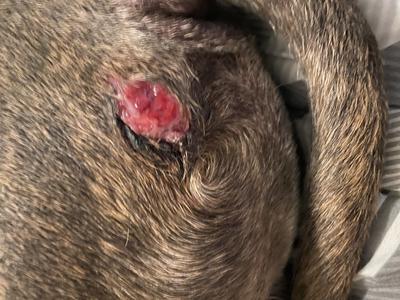Treating an Open Wound on my Dog
by Annette Ford
(Wheatland ca yuba)

Red Open Wound on Dog Back
Please tell me what I can do for him I can’t take him to a vet till I get paid and nobody will do a payment plan.
Editor Suggestion for Treating a Red Open Wound on a Dog's Rear Back
Hi Annette,
I'm not a veterinarian, however, here are some general suggestions for treating a dog's wound. It's important to note that seeking professional veterinary advice is always recommended, especially for open wounds. However, in the meantime, you can try the following steps:
Keep the area clean: Gently clean the wound with a mild antiseptic solution or warm saline water. Avoid using hydrogen peroxide, alcohol, or any other harsh substances, as they can irritate the wound further.
Apply a non-stick dressing: Once the wound is clean and dry, you can cover it with a non-stick sterile dressing to protect it from further contamination. Make sure the dressing is large enough to cover the entire wound.
Prevent licking and biting: Dogs may try to lick or bite their wounds, which can delay the healing process or introduce infection. Use an Elizabethan collar (cone) or a protective covering, such as a snug-fitting T-shirt, to prevent the dog from accessing the wound.
Monitor for signs of infection: Keep a close eye on the wound for any signs of infection, such as increased redness, swelling, discharge, or a foul odor. If you notice any of these symptoms, it's crucial to consult a veterinarian promptly.
Antibiotic ointments - It's important to note that not all wounds require antibiotic ointments, and the decision
Each wound is unique, and the severity, location, and underlying cause of the wound can all impact the appropriate treatment. One commonly used over-the-counter ointment is a topical antibiotic ointment that contains ingredients like bacitracin, neomycin, or polymyxin B. These ointments can help prevent infection in minor wounds. However, it's crucial to read the instructions carefully and use them as directed. Remember that it's important to avoid using any ointments or medications that are intended for humans unless specifically directed by a veterinarian. Some human products can be toxic to dogs or may not be suitable for use on animal wounds.
Additionally, some veterinarians may recommend using a pet-safe antiseptic spray or gel containing ingredients such as chlorhexidine. These products can help cleanse the wound and reduce the risk of infection.
Limit activity: Restrict your dog's physical activity to prevent excessive movement that could reopen or worsen the wound. This may involve keeping them in a quiet, confined area.
Remember that these steps are not a substitute for veterinary care. If the wound worsens or your dog shows signs of pain, discomfort, infection, or distress, it's important to find a way to seek professional help as soon as possible. Consider reaching out to local animal shelters or rescue organizations, as they may have resources or suggestions for affordable veterinary care options in your area.
Please keep us up to date on your dog''s condition.
Jeff
Editor and Publisher
Dog Health Guide
Join in and write your own page! It's easy to do. How? Simply click here to return to Skin.








